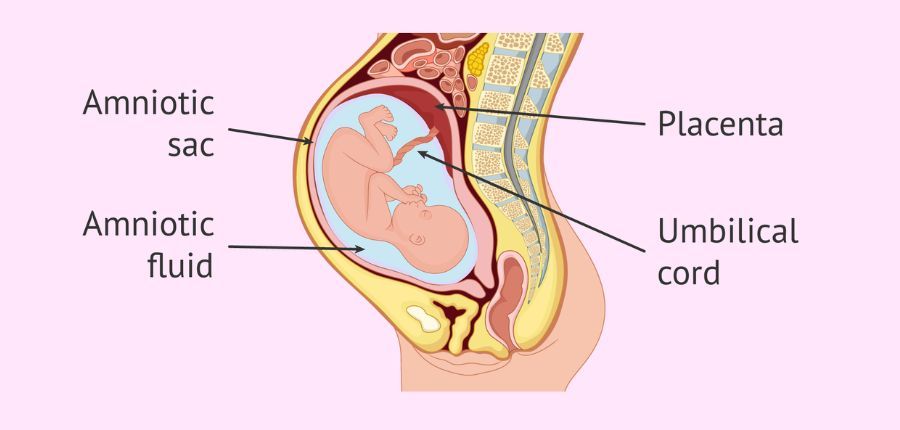What Is Amniotic Fluid?
When a baby is growing inside a mommy’s belly, there’s a special kind of water that keeps the baby safe and helps it grow strong. This special water is called amniotic fluid. Even though you can’t see it, this fluid is really important. Let’s learn all about amniotic fluid, what it does, and why it’s so important for unborn babies.

Amniotic Fluid: Unknown Facts
- Amniotic fluid is a clear, slightly yellowish liquid that surrounds and protects the developing fetus during pregnancy.
- It is primarily composed of water, electrolytes, proteins, and fetal cells.
- The fluid is contained within the amniotic sac, which forms around the embryo and later the fetus.
- Amniotic fluid serves several crucial purposes:
- Acts as a shock absorber, protecting the fetus from external pressure or impacts.
- Helps maintain a stable temperature for the developing fetus.
- Fetal lungs develop as they “breathe” the amniotic fluid, aiding in respiratory system maturation.
- It allows the fetus to move and exercise its muscles, aiding in bone and joint development.
- The volume of amniotic fluid increases as pregnancy progresses, reaching its peak around the third trimester.
- The highest amount of this fluid is usually around 34 weeks into the pregnancy, reaching an average of 800 mL. When the baby is fully developed at 40 weeks, there’s typically around 600 mL of amniotic fluid around them.
- The amniotic fluid is constantly replenished and exchanged. Fetal urine contributes to the fluid, and it’s swallowed by the fetus, absorbed through the skin, and expelled through the mother’s body.
- Amniotic fluid is crucial for various prenatal tests, such as amniocentesis, where a small sample of fluid is extracted to analyze fetal genetic and chromosomal conditions.
- Abnormal levels of amniotic fluid, either too high (polyhydramnios) or too low (oligohydramnios), can indicate potential complications in pregnancy.
- Monitoring amniotic fluid levels is an essential part of prenatal care, and medical professionals use ultrasound and other techniques to assess these levels.
- The rupture of the amniotic sac, commonly known as a woman’s “water breaking,” often signifies the start of labor.
Amniotic Fluid: Genesis And Composition
Amniotic fluid is a clear, slightly yellowish liquid that envelops the fetus in the womb. Its origins can be traced to the early stages of pregnancy.
The amniotic sac, a protective membrane that houses the fetus, begins to form around ten days after fertilization. Gradually, the amniotic sac expands, creating a nurturing environment for the developing embryo.
Comprising around 98% water, this fluid contains a diverse array of essential components. Nutrients such as carbohydrates, proteins, lipids, and electrolytes are present, serving as the building blocks for the fetus’s growth and development.
Additionally, hormones, enzymes, antibodies, and growth factors contribute to the intricate milieu that fosters the fetus’s well-being.
Functions Of Amniotic Fluid
1. Protection And Cushioning
Beyond its visually unobtrusive nature, amniotic fluid serves as a dynamic shield against external impacts. It cushions the fetus against the mother’s movements and any potential bumps, ensuring a safe haven for optimal development.
2. Temperature Regulation
Maintaining an appropriate temperature is vital for the fetus’s growth. Amniotic fluid acts as a natural thermostat, ensuring a consistent temperature environment that supports metabolic processes and prevents temperature-induced stress.
3. Respiratory And Muscular Development
As the fetus practices swallowing and inhaling, it ingests and absorbs essential nutrients from the amniotic fluid. Moreover, these movements aid in the development of respiratory muscles and prepare the fetus for the eventual transition to breathing air.
4. Nutrient Exchange And Waste Management
Amniotic fluid is a conduit through which crucial nutrients are transported from the mother to the fetus. Simultaneously, it facilitates the removal of waste products, maintaining an environment conducive to healthy growth.
5. Facilitating Limb Formation
The buoyancy provided by the fluid allows the fetus to stretch and move its limbs, contributing to the development of strong musculoskeletal structures.
Imbalances, Risks And Complications
While amniotic fluid is a marvel of nature, imbalances in its volume can pose risks to fetal health.
According to the National Institute of Health, a typical range for a normal amniotic fluid index is 5 cm to 25 cm. Measurements below 5 cm indicate oligohydramnios, while measurements exceeding 25 cm indicate polyhydramnios.
Oligohydramnios, characterized by insufficient fluid levels, could indicate issues such as poor fetal kidney function or placental complications. On the other hand, polyhydramnios, an excess of amniotic fluid, might point to fetal gastrointestinal anomalies or gestational diabetes.
Detecting and managing these imbalances is crucial to ensure a safe and healthy pregnancy journey.
Causes Of Low Amniotic Fluid
Reasons for low amniotic fluid levels, also known as oligohydramnios, can include:
- Leakage Or Rupture of Membranes: If the amniotic sac breaks too early (premature rupture of membranes), it can lead to a reduction in amniotic fluid levels.
- Placental Problems: Certain placental issues can affect the production of amniotic fluid, such as placental insufficiency or problems with blood flow to the placenta.
- Fetal Kidney Issues: If the baby’s kidneys aren’t functioning properly, they might not produce enough urine, which contributes to the amniotic fluid.
- Birth Defects: Some birth defects can lead to decreased urine production by the baby, causing a decrease in amniotic fluid.
- Dehydration: Maternal dehydration can result in reduced amniotic fluid levels. Staying properly hydrated is important for maintaining amniotic fluid volume.
- Maternal Health Conditions: Conditions like preeclampsia or chronic hypertension can affect blood flow to the placenta and impact amniotic fluid levels.
- Multiple Pregnancies: In pregnancies with twins, triplets, etc., the amniotic fluid levels might be lower due to the increased demands of multiple fetuses.
- Post-Term Pregnancy: If the pregnancy goes beyond the due date, amniotic fluid levels might start decreasing.
- Maternal Diabetes: Poorly controlled diabetes can affect fetal kidney function and lead to lower amniotic fluid levels.
- Umbilical Cord Issues: Problems with the umbilical cord’s blood flow can impact the transfer of nutrients and waste products, affecting amniotic fluid levels.
It’s important for a healthcare provider to diagnose the cause of low amniotic fluid and determine the appropriate management based on the underlying reason and the stage of pregnancy.
